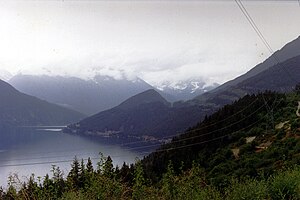Anderson Lake, British Columbia
| Anderson Lake | ||
|---|---|---|

|
||
| Geographical location | British Columbia (Canada) | |
| Tributaries | Gates River | |
| Drain | Seton River | |
| Places on the shore | Seton Portage, D'Arcy, McGillivray Falls | |
| Data | ||
| Coordinates | 50 ° 38 ′ N , 122 ° 25 ′ W | |
|
|
||
| Altitude above sea level | 251 m | |
| surface | 28.8 km² | |
| length | 21.5 km | |
| width | 1.6 km | |
| Catchment area | 728 km² | |
The Anderson Lake is a lake about 40 km west of Lillooet in the Canadian province of British Columbia is located. It is 21 km long and covers an area of about 28.5 km². The main tributary is the Gates River , the main outflow of the Seton River , which flows into Seton Lake and continues into the Fraser River .
Seton and Anderson Lakes were originally a contiguous lake, but were divided by a landslide at least 8,000 years ago. This created the Seton Portage, which was of great importance for Douglas Road , the main immigration route during the Fraser Canyon Gold Rush of 1858 to 1859. The Seton Portage Historic Provincial Park is located on the land created by the landslide .
On the north side of the lake is the southeast flank of the Bendor Range . The British Columbia Railway , now part of Canadian National Railways , was built at its foot . It was originally part of the Pacific Great Eastern Railway. A path leads from D'Arcy over the McGillivray Pass to the gold rush towns of Bralorne and Pioneer.
history
At least two villages stood by the lake in pre-European times. These were Nkua'tkwa and Nka'int of the Lillooet, as the St'at'imc were called, in whose territory the sea lay. The groups resident there were attacked at the beginning of the 19th century by around 500 men, including the Secwepemc and the Okanagan . There was also tension between the groups, but the common language, culture and trade were felt to be too strong a binding force to allow open war to break out. They were later referred to as the Seton Lake and Anderson Lake Band. In 1974 there were 144 members of the latter, 77 of whom lived as residents in the Anderson Lake Reserve. In 1992 there were 82.
The first European in the region was Francis Ermatinger of the Hudson's Bay Company . He went in 1827 from Fort Kamloops over the Peseline or Pasilico Lake (today Seton and Anderson Lakes) and over the Li-Li-What [Lillooet River].
Alexander Caulfield Anderson (1814–1884) of the Hudson's Bay Company named the lake after his grandfather Dr. James Anderson. He had surveyed the area to find a path for the fur traders from Fort Kamloops to the Lower Fraser Valley. In 1858 he was commissioned by Governor James Douglas to find a route from Harrison Lake over the lakes of the region to Lillooet, which were the main access to the gold fields on the Upper Fraser and in the Cariboo area ( Cariboo gold rush ). On that occasion, he named the second lake after his late cousin Colonel Alexander Seton. The connecting road was named Birkenhead Strait after the sunk ship whose troops Seton had commanded . Douglas Road was built from 1858, but it quickly fell out of use, although it was frequently repaired and rebuilt.
The first settlement on the lake founded by Europeans was established in 1858 with Port Anderson, today's D'Arcy, at the southern end of the lake. From there, before the Wagon Road was built, we went by canoe with two ferries to the northern end of the lake, where a nearly 3 km long portage had to be overcome to get to Lake Seton. At the end of this lake you were already close to the first gold digging sites. In September of the same year Port Anderson was founded, the N'Quatqua were forced into a reservation. Their chief Thomas Jack signed the Lillooet Declaration in 1911, with which the various groups who counted themselves among them wanted to defend themselves against the land expropriation.
In the course of the railroad construction that was to connect the Atlantic with the Pacific coast of Canada, the Pacific Great Eastern Railway , which also touched Anderson Lake , was created to open up branch lines . It connected Howe Sound north of Vancouver on the Pacific with Prince George , where the train should arrive after around 750 km. During this time Port Anderson got its current name after the politician Thomas D'Arcy McGee , who was an opponent of the annexation of Canada to the USA. He was murdered on April 7, 1868.
On the lake is the place D'Arcy or N'Quatqua and McGillivray Falls. Canadians and Japanese of Japanese descent were interned here during the Second World War. However, the conditions were not as brutal as in other places. The remoteness of the place allowed the men to work in the timber industry.
Since 1999 land management has been in the hands of the N'Quatqua , who own two reserves on the lake. These are Anderson Lake 5 with an area of 594.6 hectares and Nequatque 1 with 177 hectares , which practically corresponds to the village of N'Quatqua at the confluence of the Gates River with Anderson Lake.
literature
- Irene Edwards: Short Portage to Lillooet , reprinted by Cold Spring Books, 1985.
Web links
Remarks
- ^ Government of Canada: Historical Hydrometric Data Search Results: Station 08ME015
- ↑ James Alexander Teit: The Lillooet Indians , 1975, pp. 246f.
- ↑ Handbook of North American Indians , Volume 12, pp. 497 and 190.
- ^ William White: Notes and Queries, Vols 158–159, Oxford University Press, 1930, p. 416.
